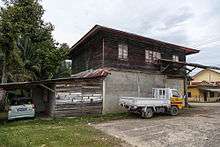Arthur Joseph West

Arthur Joseph West (c. 1863 in Worcestershire; – 2 November 1937 in Bexhill-on-Sea) was a British railway engineer. Under his leadership, the Labuan Coal Line and a line from Beaufort to Weston and Melalap which known as the North Borneo Railway were built.
Personal life
West was born in 1863 in Worcestershire, England. Nothing is known about his youth and professional career in the early. On the recommendation of his friend William Clark Cowie,[1] he was appointed as Chief Railway Engineer on 7 July 1896 by the North Borneo Chartered Company with an annual salary of 4,800 Straits dollar.[note 1] Although his previous experience was limited to the construction of the kilometre-long narrow Labuan Line, with which the coal mines of Labuan had been connected to the port of Victoria Town,[3] his position are completely independent from any control of the Governor while mainly directed by Cowie instead.[1]
West began his work on Bukau in 1896 as the first section for the North Borneo Railway. At the same time he had to construct both the line to north direction of Beaufort and to the south of Brunei Bay. As been selected by Cowie, the ending point of the line on the Brunei Bay proved to be too shallow as it was a mangrove forest areas. West called the station there as "West City", which later became Weston. West married privately to Mary Louisa; and had two children named Gilbert and Willie. His first son was born in Labuan and baptised there on 28 November 1897 by the Governor of Beaufort.[4] His family remained in the island during the first phase of construction of the North Borneo Railway.

On 3 February 1898, barely two years since the beginning of the rail construction, the first railway service rolled its way.[5] However, completion of the entire Beaufort–Weston section lasted for four years. From 1900, West used all his energy to expand the railway line along the Padas River to Tenom and then to Melalap. Tenom was reached in 1905, while Melalap in 1906. On 1 April 1900, his family moved to Bukau where they permanently resided in a house there.[6] His two sons received an academic and technical education in Cambridge and entered a technical career; Gilbert, the older of the two became an assistant chief engineer at the British Broadcasting Company (BBC) while Willie became a geologist.[7]
As his career and presence was mainly linked to Cowie, with the death of Cowie's in 1910; he was then relieved from his post and left Borneo.[8] West died on 2 November 1937 in Bexhill-on-Sea.[9][note 2]
Notes
- ↑ At this time, the value of the Straits dollar was tied to the Mexican dollar and equaled the equivalent of 1 oz. Silver.[2]
- ↑ His wife, Mary Louisa died on 12 March 1959. Source: British National Archives. Archive of the estate administrators Charles Sheppard and Sons, investigation into the cause of death Az. WEST SHE/2/7/1199.
Literature
- K. G. Tregonning (1965). A History of Modern Sabah (North Borneo, 1881-1963). University of Singapore.
References
- 1 2 K. G. Tregonning. p. 56.
- ↑ Sabah State Archives, Kota Kinabalu: BNBCC personnel records; Written agreement of the Supervisory Board with West dated 7 July 1896 ("Agreement letter").
- ↑ Stephen R. Evans; Abdul Rahman Zainal; Rod Wong Khet Ngee (1996). The history of Labuan Island (Victoria Island). Calender Print Pte Ltd. ISBN 978-981-00-7764-8.
- ↑ British North Borneo Herald, 16 December 1897, p. 359.
- ↑ British North Borneo Chartered Company (1899). "Views of British North Borneo : with a brief history of the colony, compiled from official records and other sources of information of an authentic nature, with trade returns, &c., showing the progress and development of the chartered company's territory to the latest date ." Cornell, Americana. Internet Archive. Retrieved 18 May 2017.
- ↑ British North Borneo Herald, 1 May 1900, p. 139. ("Labuan Notes").
- ↑ British North Borneo Herald, 2 November 1923, p. 190.
- ↑ K. G. Tregonning. p. 62.
- ↑ "BORNEO RAILWAY BUILDER DIES". The Straits Times. National Library Board, Singapore. 3 November 1971. p. 11. Retrieved 18 May 2017.